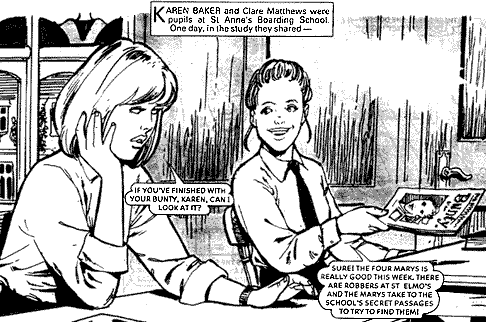
Ponies and ballet and school! If you think that's what girls comics were all about, then you never read any. Or at least, you never read any good ones.
Yes, there were ponies, usually ones that our heroine had to ride in secret/save from an evil relative who wanted to send it to the knacker's yard/tame in order to win a competition, to the astonishment of all, especially the evil snob who had money for riding lessons and thought her victory was in the bag.
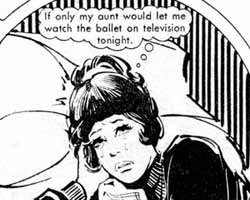 Yes, there was ballet, and girls who loved it but were forbidden to dance by aunts who were jealous of their talent, or who had lost ballerina sisters and were scared that their nieces would come to ballet-related deaths too.
Yes, there was ballet, and girls who loved it but were forbidden to dance by aunts who were jealous of their talent, or who had lost ballerina sisters and were scared that their nieces would come to ballet-related deaths too.
And of course there were schools, from the Angela Brazil-ish boarding school St Elmo's of Bunty's The Four Marys, to the Grange Hill-like comp attended by Pam of Pond Hill in Jinty. Girls' comic schools of the Eighties and Nineties sometimes even had (gasp) boys in attendance!
But there was so much more...
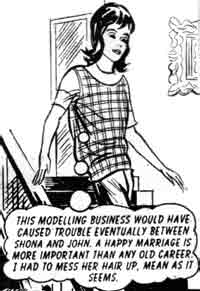 In the early days of what we'll elitistly call 'proper' girls' comics - those which included comic strips alongside their text stories and illustrated strip stories - there were a lot of aspirational figures for girls: teens or older who had nice jobs or nice fianc�s.
In the early days of what we'll elitistly call 'proper' girls' comics - those which included comic strips alongside their text stories and illustrated strip stories - there were a lot of aspirational figures for girls: teens or older who had nice jobs or nice fianc�s.
Girls were supposed to be air stewardesses or nurses, or if they were particularly special, ballet dancers or models - but were, of course, expected to give up their career when they married. Bunty's 'Sister of the Bride' had terrible trouble in the late Sixties, valiantly sabotaging her sister's career to ensure a happy marriage ensued.
Back in the first issue of Bunty, from 1958, we were introduced via text story to Lyn Raymond, Air Stewardess - 'She has the tip-toppest job of all for girls'. Lyn, who was late for her interview through helping a blind man, but got the job because he was a plant, gave us an important moral message, echoed throughout the years of girls' comics. If you selflessly stop to help blind men/lost children/ill beggars, then your kindness will be returned tenfold, and you will achieve what you thought you'd lost, while your selfish rival will lose all.
Other moral messages were delivered by comics throughout the years. IPC's supernatural comic of the Seventies, Misty, gave us new moral lessons every week, often in superb punishment-fitting-the-crime style. Don't be vain, or ugly monsters will tear you apart. Don't cause trouble at your mum's shop, or you will be turned into a shop dummy. Don't collect butterflies, or aliens will hunt and kill you for their collections. Don't eat prawns, or prawnlike aliens will eat you, having first dipped you in garlic sauce. The beauty - or horror - of Misty was that you didn't even have to be an evil person for a terrible fate to take you - you only had to have one tiny little moral hiccup, if that, to be damned for all eternity.
Misty was a comic particularly popular with boys, who would, of course, never admit to it for fear of playground beatings. But, you see, Misty was more than just another girls' comic...
Girls generally like different things to boys, storywise. They like emotion, hardship, tradegy. Action and violence are not really their cups of tea. And although nearly every person working on a girls' comic was male, they played to these strengths, producing heartrending and heartwarming stories of Victorian orphans and downtrodden gymnasts.
In the mid Seventies, DC Thomson came up with a brilliant idea: a new supernatural comic for girls, Spellbound. But it was still - well, a bit girly. While over at IPC, Pat Mills and John Wagner were among those let loose on girls' comics. The heroines were still girls. They still told the sorts of stories girls liked. But 'girly' they weren't...
Misty dealt with horror, offering tales of ghosts and deals with the devil. Jinty now interspersed its schools and gymnasts with superb science-fiction stories. Oh, Jinty's science-fiction stories! They are the pinnacle of girls' comics, and I'll pull the hair of anyone who says otherwise.
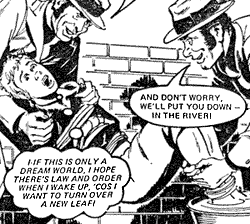 There was Land of No Tears - 'Hop-Along' Cassy, who would have horrified the Daily Mail with her desire to stay 'crippled' for the sympathy it gets her, finds herself in a future where perfection is all. There was The Human Zoo, where identical twins are captured by aliens who treat humans like animals. And most glorious of all, there was Worlds Apart, where six girls find themselves trapped in a series of worlds which are distorted versions of their own desires, and can only escape through the death of the girl whose mind they're in� Any story which starts 'The day began like any other. A road tanker carrying highly dangerous chemical waste left a government research establishment' has got to be good, but as we journeyed through the fatty, sporty, vain, criminal, brainy and scared lands, we not only got the girls' staples of peril and adversity (with some handy moral lessons), we got a superb adventure story.
There was Land of No Tears - 'Hop-Along' Cassy, who would have horrified the Daily Mail with her desire to stay 'crippled' for the sympathy it gets her, finds herself in a future where perfection is all. There was The Human Zoo, where identical twins are captured by aliens who treat humans like animals. And most glorious of all, there was Worlds Apart, where six girls find themselves trapped in a series of worlds which are distorted versions of their own desires, and can only escape through the death of the girl whose mind they're in� Any story which starts 'The day began like any other. A road tanker carrying highly dangerous chemical waste left a government research establishment' has got to be good, but as we journeyed through the fatty, sporty, vain, criminal, brainy and scared lands, we not only got the girls' staples of peril and adversity (with some handy moral lessons), we got a superb adventure story.
The glory days couldn't last. Tammy swallowed both Misty and Jinty, and itself disappeared for good in 1984. Over at DC Thomson, the cheaper photo stories gradually took over from artwork strips, and it was all boys and pop stars and trendiness. Oh, there was still good stuff - Bunty's 1995 minor classic, The Boyfriend from Blupo (top) featured the best ever example of 'carpe diem', when heroine Lee, desperate to find a date for the school disco, propositions the alien boy whose space ship has just crashed in front of her.
But Bunty - the first and the last - finally disappeared in 2001, and that was it for 'proper' girls' comics. No one wants them any more (every now and again I do the rounds of publishers, but artwork is too expensive, there's no readership, and no advertisers for such a product, they say). But I'm sure there are still days like any other going on out there, with dangerous road tankers on the loose. And maybe one day we'll be able to read about them again.
 Image credits in order of appearance: Wonderful Wanda, Bunty, 1994, Lisa, The Lonely Ballerina, Bunty 1974, Sister of the Bride, Bunty 1967, The Four Marys, Bunty 1958 and 2001, all © DC Thomson. Worlds Apart, Jinty 1981, © IPC Media. Boyfriend from Blupo, Bunty, 1995, © DC Thomson.
Image credits in order of appearance: Wonderful Wanda, Bunty, 1994, Lisa, The Lonely Ballerina, Bunty 1974, Sister of the Bride, Bunty 1967, The Four Marys, Bunty 1958 and 2001, all © DC Thomson. Worlds Apart, Jinty 1981, © IPC Media. Boyfriend from Blupo, Bunty, 1995, © DC Thomson.
|
Trivia
Characters in Bunty were frequently seen to be reading Bunty the comic, but never commented on the fact that their lives were being laid out in pictures inside.
Statistics show that you're most likely to get your own story in a girls' comic if you're a sporty, disabled, artistic Victorian orphan who lives with a violent aunt or uncle, having a hurt sister/brother/pet who you need to earn money for, but don't realise that your best friend secretly resents you, the snobs are plotting against you, and an evil mastermind is attempting to take over your school and you're the only one who can resist her powers. However, this will count for nothing if your name doesn't lend itself to a clever titular pun.
Over forty-three years (Jan 1958 to Feb 2001), Bunty's The Four Marys went through several looks, lots of school hols and a change of headmistress, but the girls stayed in the Third Form throughout.
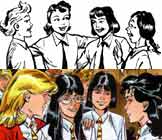
In the Nineties, DC Thomson's Mandy and Judy became the trendier-sounding M&J, while Bunty's title character, Bunty, became known simply as 'B'.
Bunty's back page 'cut-out wardrobe' may have made many little girls grow up to be fashion designers, but is the bane of collectors who want to find pristine copies of comics�
For a while in the Eighties, Tammy listed writers and artists for its strips. Suddenly we could discuss the gloriously detailed art of Jose Casanovas, and the simple, elegant style of Guy Peeters. We knew that Benita Brown wrote Tomorrow Town, and Jake Adams wrote ET Estate, and wondered if they'd written the sci-fi classics of the past...
Judy's 'Nothing Ever Goes Right!' epitomised the girls' comics' love of tragedy. After a series of disasters, the last episode saw heroine Heather ending up in an unnamed grave.
'Tamara Townsend is forced to join a secret legion of girl slaves known as "Ants", whose leader, the Grand Termite, plans to make himself master of the world.' Other evil masterminds hypnotised girls to swim oceans, turned girls into plants, and were really keen on ballet.
'Marian Lowther, an orphan and millionairess, was delicate and very bored with life until she made friends with her new cook's daughter, Joan Coombes. The pair began to collect autographs�' and became the original stalkers. This Bunty pair, with unlimited money and seemingly no shame, should have been locked up.
Karen, The Loneliest Girl in the World, should have watched Doctor Who - could the Kraals have been behind her ordeal?
'A talent for matchstick models - that's all that made life worthwhile for Sadie.' And despite the best efforts of her evil guardian, Sadie in the Sticks managed to make �50 plus a time for them, which was pretty impressive for the Seventies.
|


